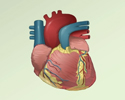Body mass index
A good way to decide if your weight is healthy for your height is to figure out your body mass index (BMI). You and your health care provider can use your BMI to estimate how much body fat you have.
Information
Having obesity puts a strain on your heart and can lead to serious health problems. These include:
Obesity
Obesity means weighing more than what is healthy for a given height. Obesity is a serious, chronic disease. It can lead to other health problems, i...

Serious health problems
Obesity means weighing more than what is healthy for a given height. Obesity is a serious, chronic disease. It can lead to other health problems, i...

- Arthritis in your knees and hips
Arthritis
Arthritis is inflammation or degeneration of one or more joints. A joint is the area where 2 bones meet. There are more than 100 different types of...
 ImageRead Article Now Book Mark Article
ImageRead Article Now Book Mark Article - Heart disease
Heart disease
Coronary heart disease is a narrowing of the blood vessels that supply blood and oxygen to the heart. Coronary heart disease (CHD) is also called co...
 ImageRead Article Now Book Mark Article
ImageRead Article Now Book Mark Article - High blood pressure
High blood pressure
Blood pressure is a measurement of the force exerted against the walls of your arteries as your heart pumps blood to your body. Hypertension is the ...
 ImageRead Article Now Book Mark Article
ImageRead Article Now Book Mark Article - Sleep apnea
Sleep apnea
Obstructive sleep apnea (OSA) is a problem in which your breathing pauses during sleep. This occurs because of narrowed or blocked airways.
 ImageRead Article Now Book Mark Article
ImageRead Article Now Book Mark Article - Type 2 diabetes
Type 2 diabetes
Type 2 diabetes is a lifelong (chronic) disease in which there is a high level of sugar (glucose) in the blood. Type 2 diabetes is the most common f...
 ImageRead Article Now Book Mark Article
ImageRead Article Now Book Mark Article - Varicose veins
Varicose veins
Varicose veins are swollen, twisted, and enlarged veins that you can see under the skin. They are often red or blue in color. They most often appea...
 ImageRead Article Now Book Mark Article
ImageRead Article Now Book Mark Article
HOW TO DETERMINE YOUR BMI
Your BMI estimates how much you should weigh based on your height.
There are many websites with calculators that give your BMI when you enter your weight and height.
You can also calculate it yourself:
- Multiply your weight in pounds by 703.
- Divide that answer by your height in inches.
- Divide that answer by your height in inches again.
For example, a woman who weighs 270 pounds (lbs) or 122 kilograms (kgs) and is 68 inches (in) or 172 centimeters (cm) tall has a BMI of 41.0.
Use the chart below to see what category your BMI falls into, and whether you need to be concerned about your weight.
| BMI | CATEGORY |
|---|---|
| Below 18.5 | Underweight |
| 18.5 to 24.9 | Healthy |
| 25.0 to 29.9 | Overweight |
| 30.0 to 39.9 | Obese |
| Over 40 | Severe or high risk obesity |
There are three classes of obesity:
- Class 1: BMI of 30 to less than 35.
- Class 2: BMI of 35 to less than 40.
- Class 3: BMI of 40 or higher. Class 3 is considered "severe obesity."
BMI is not always the best way to decide whether you need to lose weight. If you have more or less muscle than is normal, your BMI may not be a perfect measure of how much body fat you have. For example:
- Body builders-- Because muscle weighs more than fat, people who are very muscular may have a high BMI.
- Older people -- Healthy weight ranges for older adults are different than for other age groups. The BMI only tells part of the story. Older adults with a normal BMI may have less muscle compared to others who are slightly overweight. If you are 65 years or older, a slightly higher BMI may help protect you from thinning of the bones (osteoporosis). Always talk to your provider before trying to lose or gain weight.
- Children -- While many children have obesity, Do not use this BMI calculator for evaluating a child. Talk to your child's provider about the right weight for your child's age.
Providers use a few methods to decide whether you are overweight. Your provider may also take your waist circumference and waist-to-hip ratio into consideration.
Your BMI alone can't predict your health risk, but most experts say that a BMI of 30 or greater (obesity) is unhealthy. No matter what your BMI is, exercise can help reduce your risk of developing heart disease and diabetes. Remember to always talk to your provider before starting an exercise program.
Reviewed By
Linda J. Vorvick, MD, Clinical Professor, Department of Family Medicine, UW Medicine, School of Medicine, University of Washington, Seattle, WA. Also reviewed by David C. Dugdale, MD, Medical Director, Brenda Conaway, Editorial Director, and the A.D.A.M. Editorial team.
Centers for Disease Control and Prevention website. About body mass index (BMI). www.cdc.gov/bmi/about/index.html. Updated May 20, 2024. Accessed July 30, 2024.
Gahagan S. Overweight and obesity. In: Kliegman RM, St. Geme JW, Blum NJ, et al, eds. Nelson Textbook of Pediatrics. 22nd ed. Philadelphia, PA: Elsevier; 2025:chap 65.
Jensen MD, Bessesen DH. Obesity. In: Goldman L, Cooney KA, eds. Goldman-Cecil Medicine. 27th ed. Philadelphia, PA: Elsevier; 2024:chap 201.

 All rights reserved.
All rights reserved.